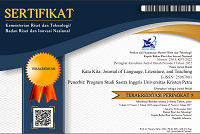Rhetorical Devices Used by Bill Gross in Presenting His Speech on Start-up Success
DOI:
https://doi.org/10.9744/katakita.11.2.231-239Keywords:
biocompositeAbstract
This study, using a qualitative approach, was conducted to find out the rhetorical devices used by Bill Gross when presenting his speech on start-up success, including the function of each of the devices used. The presentation was divided into three parts: introduction, body, and conclusion. In conducting the research, the writer used the theory proposed by Harris (2018). The findings showed that the speaker used all of the rhetorical devices under the three categories, namely: Emphasis, Transition, and Clarity. Each device also has different functions depending on the context of the presentation: to raise the topic’s importance, to provide emphasis, to provide clarity, to maintain the audience’ curiosity, to show the impression of spontaneity, to elaborate details, to help the audience understand better, to anticipate question, and to anticipate ambiguity. In conclusion, the rhetorical devices, particularly hypophora and amplification as the mostly used ones, were applied by Bill Gross to better deliver his presentation.References
Andrews, R. (2013). A theory of contemporary Rhetoric. Routledge.
https://www.routledge.com/A-Theory-of-Contemporary-Rhetoric/Andrews/p/book/9780415503556
Carter, R., & McCarthy, M. (2006). Cambridge grammar of english: A comprehensive guide to spoken and written english usage. Cambridge University Press.
Chandra, J. C. (2022). Rhetorical devices used by Simon Sinek when delivering an inspirational speech [Bachelor’s Thesis, Petra Christian University]. PCU Repository. https://dewey.petra.ac.id/catalog/digital/detail?id=53113
Harris, R. A. (2018). Writing with clarity and style: A guide to rhetorical devices for contemporary writers. (2nd ed.). Routledge.
Idealab. (n.d). About Idealab.
Kusumastuti, A., & Khoiron, A. M. (2019). Metode penelitian kualitatif. Lembaga Pendidikan Sukarno Pressindo.
Lucas, S. (2011). The art of public speaking. McGraw-Hill Humanities.
https://www.amazon.com/s?k=The+Art+of+Public+Speaking&i=stripbooks
Mackey. A., & Gass, S. M. (2005). Second language research methodology and design. Lawrence Erlbaum Associates.
https://www.amazon.com/s?k=Second+language+research%3A+methodology+and+design&i=stripbooks
Oxford Dictionary (n.d). Extrapolation. https://www.oxfordlearnersdictionaries.com/definition/english/extrapolation?q=extrapolation
San Diego State University (2021). What is Rhetoric?.
https://rhetoric.sdsu.edu/about/what-is-rhetoric
Setyawan, R. (2022). Rhetorical devices used by content creators to address the boycott of the game Dead By Daylight [Bachelor’s Thesis, Petra Christian University]. PCU Repository. https://dewey.petra.ac.id/catalog/digital/detail?id=53112
Ted Talk. (n.d). About Bill Gross.
https://www.ted.com/speakers/bill_gross
Yang, M. (2019). The application of English Rhetorical devices in speechwriting. Atlantis Press
Downloads
Published
Issue
Section
License
Authors who publish with this journal agree to the following terms:- Authors retain copyright and grant the journal right of first publication with the work simultaneously licensed under a Creative Commons Attribution License that allows others to share the work with an acknowledgement of the work's authorship and initial publication in this journal.
- Authors are able to enter into separate, additional contractual arrangements for the non-exclusive distribution of the journal's published version of the work (e.g., post it to an institutional repository or publish it in a book), with an acknowledgement of its initial publication in this journal.
- Authors are permitted and encouraged to post their work online (e.g., in institutional repositories or on their website) prior to and during the submission process, as it can lead to productive exchanges, as well as earlier and greater citation of published work (See The Effect of Open Access).














